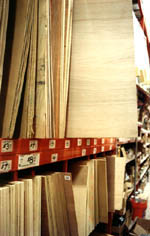
 |
 
Plywood (lauan, meranti, serai)
 
Lauan production began in earnest in the 1930s when Japanese logging companies began targeting the forests of the Philippines. Originally loggers targeted the largest trees in the forests. These were the giants, red lauan (Shorea negrosensis or Shorea polysperma) and white lauan (Pentacme contorta [Shorea contorta] or Parashorea malaanonan). However, it was the development of a new method of making plywood that doomed the forests of the Philippines, Malaysian Borneo and Indonesian Borneo (and perhaps eventually the Solomon Islands, Gabon, Central African Republic and the Amazon as only time will tell). This method uses a long blade that peels a thin layer of wood (veneer) off the log sideways, as the log spins on a rotary (like a roll of paper towels), rather than the old way of slicing the log through from end-to-end. This new method allowed the loggers to target all the large trees in the forest. In the Philippines, like most of the rainforests in Asia, the family of trees known as Dipterocarpacea, or dipterocarps, make up 80% of the trees of the forests. The entire family was targeted by loggers, who eventually eliminated 80% of the forests of the Philippines. For more on illegal logging and the impacts of logging in the Philippines, click here. When the trees began to run out there, the international logging companies moved on, first to Thailand, then to Malaysia and eventually to Indonesia. Indigenous people in Malaysia have been severely impacted by logging of their customary lands. For more on logging and its impacts in Malaysia, click here. Indonesia built a huge plywood and wood export industry based on the liquidation of the forests of Indonesian Borneo (called Kalimantan). For more on illegal logging and the impacts of logging in Indonesia, click here. Lauan plywood is used for the facing of interior doors, for the backing of wood and faux-wood paneling, for the interior walls of truck bodies, RVs and trailers, shipping containers, subflooring, movie and theatre set construction, cabinet interiors and backing, furniture backing and drawers, picture frame backing and crafts. In 1997, With the help of Action Resource Center and other groups across the US, Rainforest Relief focused on The Home Depot's continuing sales of wood from rainforests, with particular emphasis on lauan. HD was selling lauan as plywood sheets but also as interior hollow-core doors, by the tens of thousands per year. Most of the hollow-core doors sold in the US since the late 1950s have been faced with lauan. These doors are used for bedrooms and closets (as opposed to an exterior entry door). Also, HD was selling thousands of sheets a year of interior paneling, mostly backed with lauan plywood. The Home Depot and Lowe's both pledged to end their sales of wood from endangered forests but have failed to completely phase out of lauan. Rainforest Relief continues to campaign against the use of lauan, targeting theatrical and movie set contruction (our Safe Sets™ campaign), as well as its use in the construction of truck bodies. Click here for alternatives to lauan plywood, found in the By Species section. |
 |
 |
|||||||||||||||||
 Copyright 2006 Rainforest Relief |
||||||||||||||||||||
